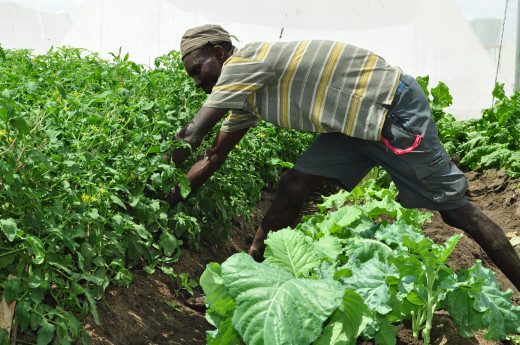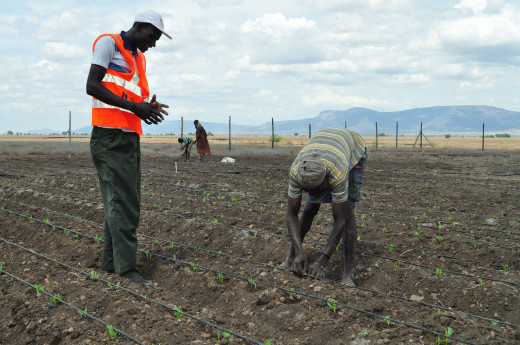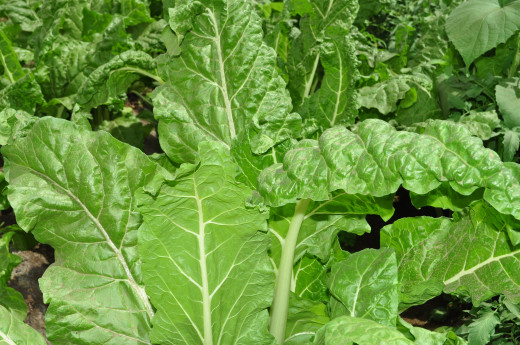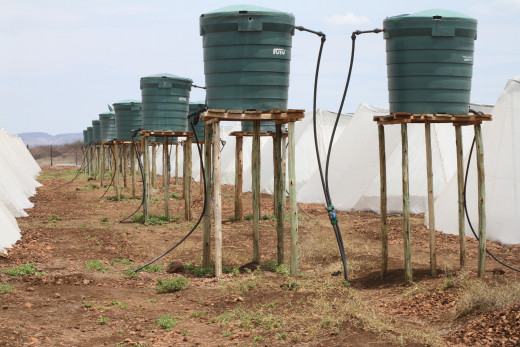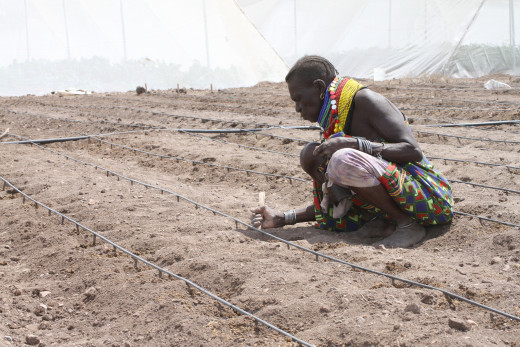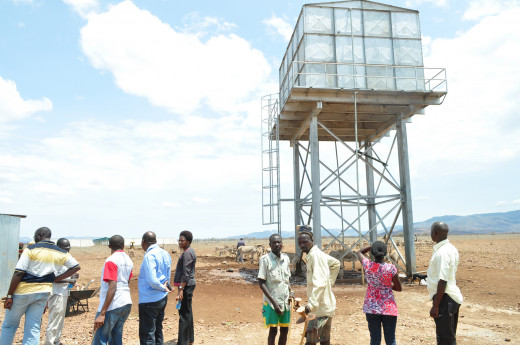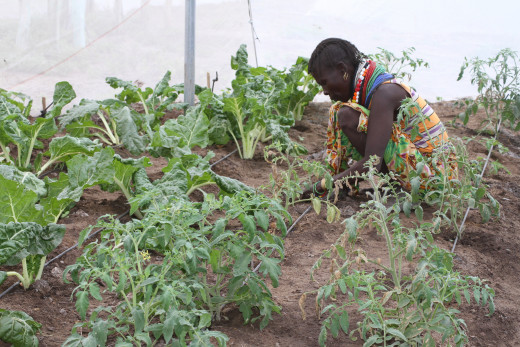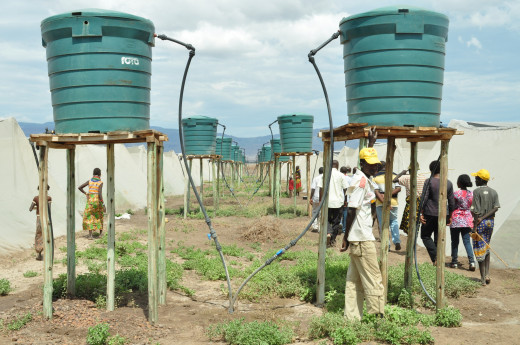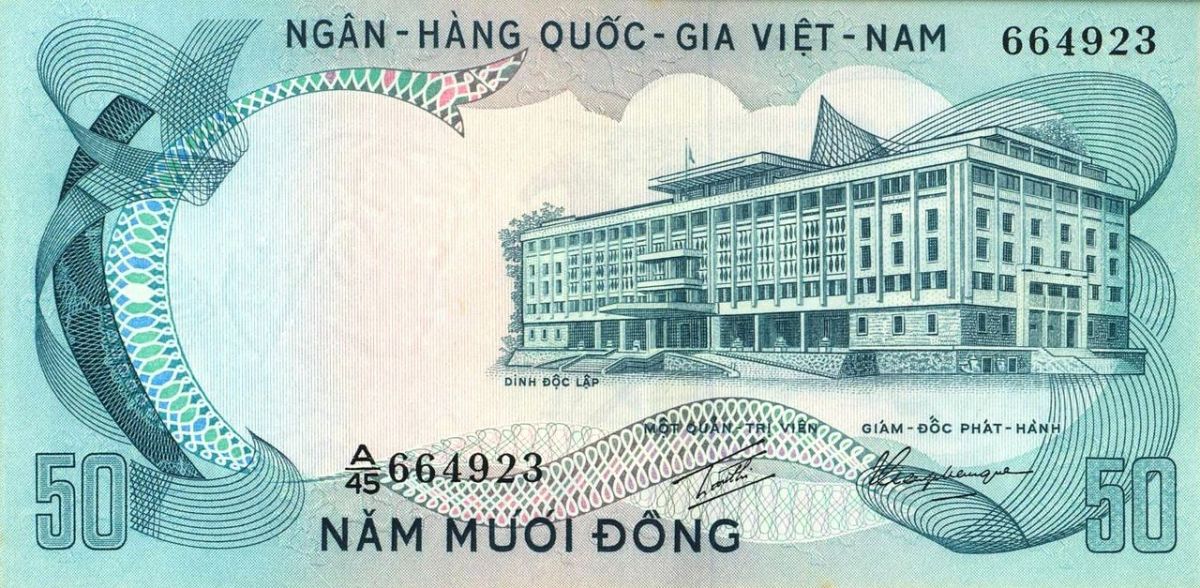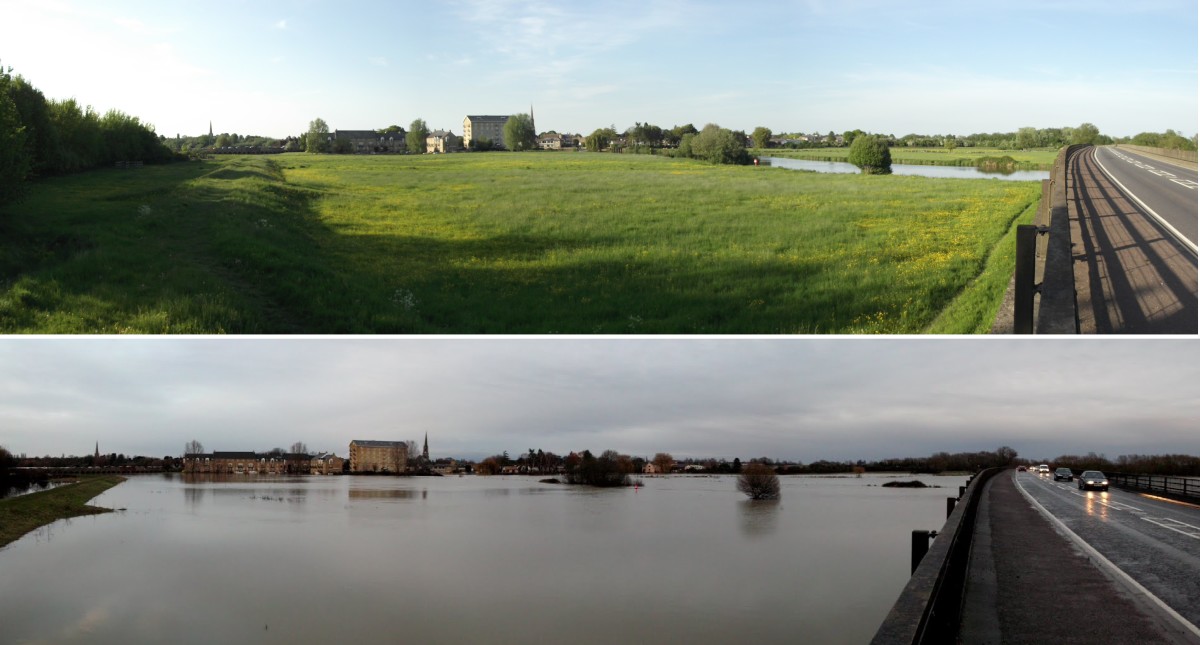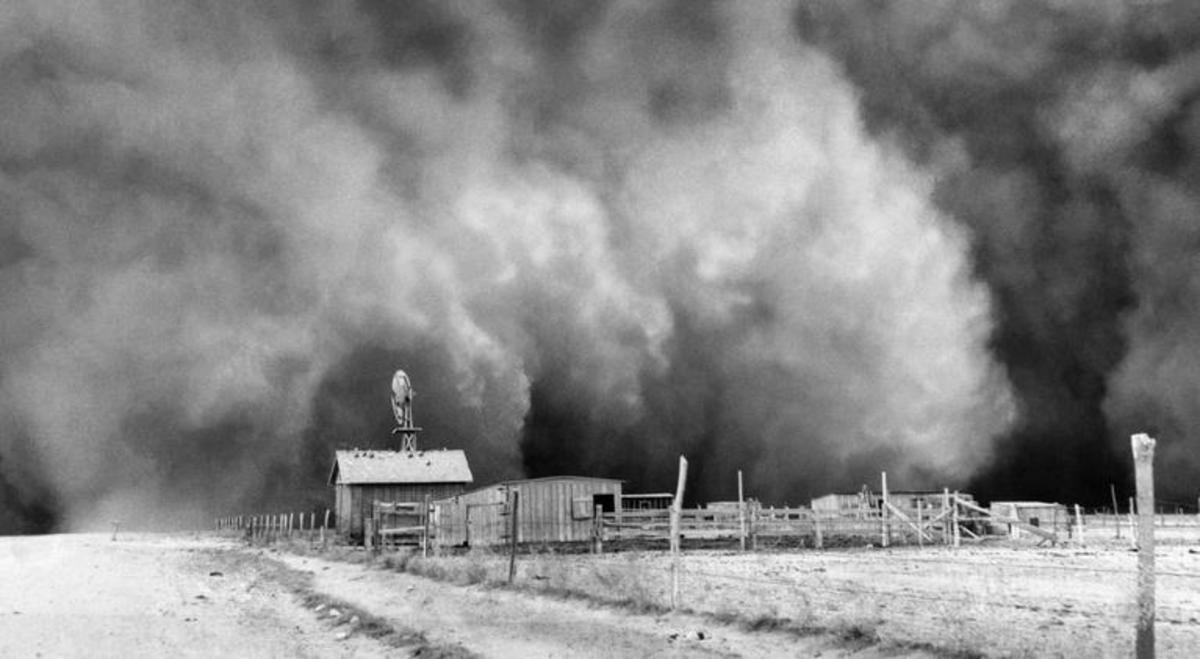THE POTENTIAL AND CHALLENGES OF CROP AGRICULTURE IN TURKANA COUNTY, KENYA. A case study of Kaikor Location.
THE POTENTIAL AND CHALLENGES OF CROP AGRICULTURE IN TURKANA, KENYA: A Case Study of Kaikor Location
Catholic University of Eastern Africa
Faculty of Arts and Social Sciences, Department of Development Studies
THE POTENTIAL AND CHALLENGES OF CROP AGRICULTURE IN TURKANA: A Case Study of Kaikor Location
BY
Edward Njuguna Mbugua
Registration No: 1022257
A research project submitted in partial fulfillment of the requirements for the bachelor of development studies at the Faculty of Arts and Social Sciences of the Catholic University of Eastern Africa.
14th September, 2014
I hereby declare that this is my original work and has not been presented to any other university for the award of a degree.
Name: Edward Njuguna Mbugua
Sign…………………………Date………………………..
Declaration by Supervisor
This research project has been submitted with my approval of the student’s supervisor
Signature……………………Date…………………………
Mr. MICHEAL OKUKU
This project has been accepted by:
Sign………………………….Date…………………………
HOD Development Studies
DEDICATION
I dedicate this research project to my family members, friends, and my school supervisor for the invaluable support they accorded me as I was conducting this study. Without them, this research project would not have been a success.
ACKNOWLEDGMENT
I feel privileged to have had an opportunity to study at the Catholic University of Eastern Africa which equipped me with the necessary skills and knowhow on how to conduct this study as a demonstration of knowledge gained during the period studying for my bachelor’s degree. I would therefore like to recognize and appreciate all those contributed directly or indirectly in the compilation of this research project.
First and foremost I would like to thank the almighty God for giving me the courage and strength to carry out this study. I am deeply indebted to my university supervisor for his guidance and support without whose help this project would not have been a success. Finally I would like to thank all my family members and friends for their encouragement and constant source of motivation as I was conducting this study.
May God bless you abundantly.
TABLE OF CONTENTS
DECLARATION.. ii
DEDICATION.. iii
ACKNOWLEDGMENT.. iv
TABLE OF CONTENTS. v
LIST OF TABLES. vii
ABBREVIATIONS AND ACRONYMS. viii
ABSTRACT.. x
CHAPTER ONE.. 1
INTRODUCTION.. 1
1.1 Background to the Problem.. 1
1.2 Statement and Justification of the Problem.. 2
1.3 Research Objectives. 3
1.4 Research Questions. 3
1.5 Significance of the Study. 4
1.6 Description of the Area or Location. 5
1.7 Scope and Limitation. 5
CHAPTER TWO.. 7
LITERATURE REVIEW... 7
2.1 Introduction. 7
2.2 Critical review of theories. 7
2.3 Gaps in the theories (criticism of the theories) 12
2.4 Critical Review of Empirical studies (literature reviewed) 12
2.5 Gaps and Criticisms in the Empirical studies. 13
CHAPTER THREE.. 14
RESEARCH DESIGN AND METHODOLOGY.. 14
3.1 Introduction. 14
3.2 Research design. 14
3.3 Target population. 14
3.4 Description of Research instruments. 15
3.5 Description of the sample and sampling procedures. 15
3.6 Description of Data Collection Techniques. 16
3.7 Description of data analysis procedures. 16
CHAPTER FOUR.. 17
PRESENTATION DISCUSSION AND INTERPRETATION OF FINDINGS. 17
4.1 Presentation of the Research Findings. 17
4.2 General Information. 18
CHAPTER FIVE.. 26
SUMMARY, CONCLUSIONS AND RECOMMENDATIONS. 26
5.1 Summary of the Findings. 26
5.2 Conclusions. 27
5.3 Recommendations. 27
APPENDICES. 29
LIST OF TABLES
Table 4:1: Response Rate.............................................................................................................. 17
Table 4.2: Gender Composition..................................................................................................... 18
Table 4.3: Age Distribution........................................................................................................... 18
Table 4.4: Level Of Education...................................................................................................... 19
Table 4.5 Resident In Kaikor Location......................................................................................... 19
Table 4.6 Duration Of Staying Or Operation In Kaikor Location................................................ 20
Table 4.7 Source Of Income Of The Respondents....................................................................... 20
Table 4.8 Land Ownership............................................................................................................ 21
Table 4.9 Acre Of The Land Owned............................................................................................ 21
Table 4.10 How The Land Is Being Used..................................................................................... 22
Table 4.11: Respondents Role In Crop Agricultural Projects....................................................... 22
Table 4.12: Implementation And Management Of Crop Agricultural Projects By Non-Governmental Organizations................................................................................................................................................ 23
Table 4.13: Whether Crop Agriculture Has Contributed Towards Food Security In Kaikor....... 24
Table 4.14: Whether Kenyan Government Is Working Towards Ensuring The Area Is Food Secure 24
Table 4.15: How Crop Agriculture Affected The Lives Of Kaikor Residents............................. 25
Table 4.16: How Crop Agriculture Has Altered Climatic Patterns In Kaikor Location............... 25
ABBREVIATIONS AND ACRONYMS
KRCS- Kenya Red Cross Society
ASAL - Arid and semi-arid lands
IEBC- Independent Electoral and Boundaries Commission
WFP- World Food Program
MDG- Millennium Development Goals
ABSTRACT
The practice of Crop agriculture is the art of planting seeds into the soil for the sole purpose of producing plant yields over a period of time. Crop agriculture can be rain feed or rely on modern irrigation systems such as drip irrigation which ensures that there is availability of water all year round and thus guarantees a higher crop yield.
The general objective of this study was to find out how crop agriculture in Turkana County, Kaikor location has contributed to food security as well as the local economy of this area of study. The study targeted to investigate the impacts of non-governmental organizations overseeing crop agriculture in the location of study such as the Red Cross as well as the contributions of the practice on the people of Kaikor location. Both primary and secondary sources of data, which are both qualitative and quantitative in nature, were used for the study.
It can be deduced from this study that, crop agriculture had both positive impacts and negative impacts on the people of Kaikor location, Turkana County. The positive impacts of the practice of crop agriculture centered on cautioning the people against drought and thus ensuring they are food secure, positive climate change as a result of increasing vegetation cover and improvement of the local economy through the sale of surplus crop yields to the local markets. The negative impacts were on the culture of the people of kaikor location which involved changing from a largely pastoralist lifestyle to being subsistence farmers. The study recommends how the negative impacts can be minimized while at the same time maximizing the positive impacts. These recommendations are discussed in depth in this study.
This chapter contains a detailed background to the problem under study, problem statement, research objectives, research questions that will guide the study, significance of the proposed research topic, description of the area or location and the scope and limitation of the study.
1.1 Background to the Problem
In 2010-2011 Kaikor location, in Turkana north was hit with drought which led to severe malnutrition rates as high as 35% and loss of life due to it being an arid area. There was therefore need to adapt crop agriculture and modern methods of irrigation to ensure that the area is food secure and the livelihoods of the local people are sustainable.
The Kenya Red Cross Society in partnership with the Government through an initiative dubbed Kenyans for Kenya mobilized for funds from Kenyans, stake holders as well as other well wishers to purchase and supply relief food to the local populous in Kaikor, Turkana north to prevent any further loss of life. This was purely a residual service as it was emergency based and therefore in later years would not be deemed to be sustainable. A permanent solution therefore to the perennial drought needed to be made which now came in the form of adaptation of crop agriculture in the area. (Kenya Red Cross, 2011)
The Kenya Red Cross Society (KRCS) and the Kenyans for Kenya Steering Committee on Tuesday 16th July; 2013 commissioned an irrigation project in Kaikor area of Turkana County. The project was aimed at providing a permanent solution to the perennial drought experienced in the region through building community resilience and enhancing food security.
KRCS through the Kenyans for Kenya Drought Initiative of 2011 identified parts of the Turkana County as one of the Regions that were going to gain from early recovery initiatives. These initiatives were aimed at opening up land to irrigation in Kaikor location, Turkana North District, targeting three villages with a total population of 15,398 people. (Kenya Red Cross, 2011)
The project started in January 2012, with a project life of 12 months through funding from the Kenyans for Kenya Drought Initiative, where Kenyans came together to contribute through mobile telephony and other means, to reverse the fate of other Kenyans who were threatened by death through starvation. Other projects put up by KRCS under this initiative include four boreholes that were drilled and equipped, seeds and seedlings bought. (Kenya Red Cross, 2011)
Currently, results of the initiative in the dry area, that had never been thought to produce farm products, can be seen as farmers are reaping from the project after growing assorted vegetables that include kales and maize, among other products. (Kenya Red Cross, 2011) The community has also been mobilized into enterprise agriculture/common interest groups with the aim of selling the surplus for sustainability. The farmers have also been trained on kitchen gardens and basic farming skills. (Kenya Red Cross, 2011)
1.2 Statement and Justification of the Problem
This research study endeavors to address the potential and challenges of crop agriculture in the area by interrogating the positive and negative impacts of the practice on the people as well as the challenges experienced by the non-governmental organizations overseeing these projects which may include although not limited to insecurity, inadequate funding, mismanagement and culture shock experienced by their labor force.
It also interrogates the contributions of the government towards crop agriculture in Kaikor location and the challenges it encounters to ensure that the project is run smoothly and that there is no further loss of life due to drought. This is in support of the first millennium development goal on eradication of poverty and hunger.
1.3 Research Objectives
The overall objective of this proposed study is to determine the potential and challenges of crop agriculture on the people of Kaikor location, Turkana County. The specific objectives include the following:
- To determine the types of crops adopted in crop agricultural projects in Kaikor location.
- To determine the different forms of modern agricultural practices adopted in crop agricultural projects in Kaikor location.
- To determine the impacts and challenges of non-governmental organizations in the implementation and management of crop agricultural projects in Kaikor location.
- To determine the positive and negative impacts of crop agriculture on the residents of Kaikor location.
- To determine the impacts of crop agriculture on climate change in Kaikor location, Turkana County.
1.4 Research Questions
The research questions of this study include the following:
- What are the types of crops adopted in crop agricultural projects in Kaikor location?
- What are the different forms of modern agricultural practices adopted in crop agricultural projects in Kaikor location?
- Is there any positive or negative impact of crop agriculture on the residents of Kaikor location?
- What are the impacts and challenges of non-governmental organizations involved in the implementation and management of crop agricultural projects in Kaikor location?
- To what extent has crop agriculture affected climate change in Kaikor location, Turkana County?
1.5 Significance of the Study
The findings of this study will be useful to the following stakeholders and interested parties who include:
The findings of the study will help the local populous to attain a clear understanding of best agricultural practices, in terms of the advantages of using hybrid seeds to counter the prevailing harsh arid conditions. The study shall also give them a broader understanding of how crop agriculture contributes to their larger local economy. The study will also seek to inform the locals on the positive contributions of crop agriculture on the environment as well as overall climatic change which is in line with the millennium development goals on achievement of a sustainable environment.
The findings of this study will help the non-governmental organizations working in the area to determine the positive impacts of crop agriculture in Kaikor location to ensure that the area is food secure. It will also help to highlight some of the challenges they are facing such as insecurity, inadequate funding, mismanagement and culture shock experienced by their labor force as well as the well the solutions recommended by this study.
The findings of this study will help the government to analyze the contributions of crop agriculture towards food security in Kaikor location, Turkana County. This study will also help the government to determine the amount of resources it will save as a result of adopting crop agriculture in the area as opposed to directing them to residual services such as buying relief food year in year out due to drought. These resources will now be directed towards other development projects such as infrastructure. The findings and recommendations of this study can also be used by the government to determine the extent to which the millennium development goal on achievement of environmental sustainability has been promoted and attained.
1.6 Description of the Area or Location
The area under study was Kaikor Location which is located in Turkana north constituency in Northern Kenya. Turkana North borders Uganda to the west, Sudan to the Northwest and Ethiopia to the Northeast. Turkana North Constituency covers an area of approximately 35,418.8 Km sq. It has a population of 374,414(2009 census) of which 197,508 are men and 176,906 respectively. Out of this total population, Kaikor has a total of 15, 398 people (Chemmuttut. P, 2012)
According to the World Food Program (WFP), Most of the region consists of low-lying plains, with isolated mountainous and hilly ranges. The altitude rises at the foot of the escarpment along the Uganda border to the West and then falls towards the shores of Lake Turkana in the East. Turkana North has both arid and semi-arid lands (ASAL), with temperatures ranging from 24ºC to 38ºC. Rainfall in the area is erratic and highly variable. The main lively hood in the area is pastoral (60% of the population). Other livelihood zones include agro-pastoral, mainly in the Riverside areas of Turkwel and Kerio (20%); fisher folk along the shores of Lake Turkana (12%) and the formal/casual waged labor/business and trade located in the major towns (8%). As a result of crop agricultural projects in Kaikor and other parts of Turkana, agricultural activities have spread to other areas that do not necessarily have rivers. They are based on irrigation which sources its water from boreholes and underground streams (World Food Program, 2012)
1.7 Scope and Limitation
The study was concern with analyzing the potential and challenges of crop agriculture in Kaikor location, Turkana County as well as its’ impact on the local populous. Data was collected by the researcher using questioners, focused group discussions as well as document review on the subject of crop agriculture in arid areas. During the study, several discussions were held between the researcher and the locals to come up with reliable data on how crop agriculture has contributed to the lives of the people living in Kaikor location as well as the local economy. The respondents included the labor force of non-governmental organizations and the residents of Kaikor.
The process of conducting the study had some limitations which include: time and financial constraints as well as insecurity and cultural hindrances. The study was conducted in five months due to the area under study being far away as well as the poor condition of road networks used to get to Kaikor location. The study also encountered some financial constraints as the researcher bore high transport costs as well high printing costs of data collection tools such as the questionnaires. The study was also subject to cultural constraints as some residents did not understand the language used in the questionnaires. Some residents were naturally hostile to outsiders/ visitors because of the constant conflicts between them and their neighbors which are as a result of cattle rustling practices. This mal-adaptive cultural practice of cattle rustling often caused insecurity in the area.
CHAPTER TWO
LITERATURE REVIEW
2.1 Introduction
This chapter critically examines the theories related to the research problem and the gaps/ criticisms of the theories. It also contains a critical review of the literature reviewed as well as its’ gaps and inconsistencies/contradictions.
2.2 Critical review of theories
The practice of crop agriculture in Kaikor location, Turkana County was due to the urgency to ensure the area is food secure and therefore is not subject to annual droughts. This action was guided by a number of scientific theoretical frameworks which serve to ensure that the project is successful through maximizing its potential to deliver to the targeted beneficiaries and minimizing any challenges that may occur thereafter.
2.2.1 Crisis intervention theory
This is a social science model that states that social dysfunction is common in society. Due to social dysfunction, individuals, groups and communities lack a coping mechanism. During a crisis, individuals, groups and communities do not function normally. The role of human service institutions such as the Kenya Red Cross Society is therefore to come to the aid of those who don’t function properly. This was evident when the organization came up with the initiative dubbed ‘Kenyans for Kenya’ which was meant to mobilize resources to purchase relief food for the people of Kaikor affected by drought. The resources were later channeled to support crop agricultural projects in the area. (Roberts, A. 2000)
This model therefore sees social problems as being normal in society. It advocates for residual services which are meant to take care of the needs of people in a crisis. Human service therefore, is an integral part of any society because everybody can get into a crisis. (Roberts, A. 2000)
2.2.2 The total perspective view model
This Model is also referred to as the ecological model or holistic model. This is a broad framework that includes a range of theories; this model is currently gaining favor with many development workers as an alternative model. It is based on the idea that the environment, social and physiological factors all contribute to social problems. Other proponents of this model also consider economic, political and cultural factors. This model is both preventive and curative as it interrogates both the overlying and underlying causes to a problem in its formulation of solutions or resolution to a crisis (William.J. 2003).
This model was widely applied in crop agricultural projects in Kaikor location in order to ensure that the area is food secure. The crop agricultural projects in Kaikor location adopted the use of hybrid seeds which produce a drought resistant strain of crops in order for them to thrive in the adversely arid area. The crops included cales, maize, beans, carrots and tomatoes. This ensured that the project is sustainable. This model also guided the implementation of the crop agricultural projects in Kaikor as it enabled the development workers to interrogate and adopt modern forms of farming practices to ensure that the project is sustainable. The project employed the use of green houses which served to regulate the temperatures for the crops. This was deemed to be very important as the green houses created some shed for the crops as opposed to exposing them to direct sunlight, which would otherwise result to catastrophic losses as the crops would dry up.
The project also adopted the use of modern irrigation systems which provided water for the crops in the green houses. Several boreholes were dug into the ground in order to tap into the underground water table. Kaikor being as arid area was observed to have a lot of sunlight, therefore the development workers resolved to adopt solar powered water pump generators to pump water from the ground into some overhead installed tanks for storage.
The use of solar powered water pumps in Kaikor crop agricultural projects was a very cost effective idea. This is because it utilized the direct sunlight as a source of energy as opposed to using diesel powered pumps which would be costly when it comes to time as well financial resources. The application of the total perspective model also helped to maximize the positive impacts of crop agriculture on the people of Kaikor, while at the same time minimizing the negative effects in order to ensure that they are comfortable in their social setting. There were several positive impacts of crop agriculture on the people of Kaikor, which include achievement of food security, contribution to the local economy as well as the people’s attainment of technical knowhow in farming activities.
Kaikor location being an arid area was always subject annual droughts which resulted hunger, loss of life and property. The implementation of crop agricultural projects in the year 2012 made the area to be food secure as food was now available in the whole year. This saved lives as well as the cattle of the kaikor residents. The people of Kaikor through the assistance of development workers were also able to sell their surplus produce to the local markets such as Lodwar town. This increased their income and ultimately contributed to their local economy.
The people of Kaikor were also able to learn and acquire technical knowhow in modern farming practices through their direct participation in the crop agricultural projects. This was particularly important as one of the goals of the project was to ensure that the people are able to practice crop farming in their own small parcels of land. The application of the total perspective model also helped to identify the negative effect of crop agriculture as it presented a very holistic view to the research problem. There was only one negative effect which was identified in the study, this was the intrusion of the culture of the people of Kaikor location which involved changing from a largely pastoralist lifestyle to being subsistence farmers. This was resolved by holding cultural activities in the communities as well as the encouragement of the people to keep hybrid cattle which more resistant to diseases and drought.
The practice of crop agriculture in Kaikor location also had some positive contribution to the local climate patterns as it increased vegetation cover in the area through the plantation of trees and grass to minimize evaporation of water from the ground. This cooled the climate to some extent and provided shade to the people from the direct sunlight during the day.
The Key assumptions of the total perspective model are that (William.J. 2003).
- Organisms are interdependent with their environment.
- Interaction patterns of organisms and their environment may lead to social problems.
- To address social problems, one must employ a total or holistic view
- It is very preventive because one examines overlying and underlying occurrences of a social problem.
- It makes development workers to be more flexible to social problems, flexibility also deals with personal biasness on the part of social service agencies and individuals (William.J. 2003).
There are various advantages of using the total perspective view in development projects.
- It ensures that there is a clear understanding of the possible causes of a social problem
- It is important for looking at possible solutions to a problem.
- It is useful in assessing each of the alternative possible solutions to a problem (William.J. 2003).
2.2.3 Contingency theory
The contingency theory, mainly applied to the Kenya Red Cross Society that was overseeing crop agricultural projects in Kaikor Location, Turkana County. It served to ensure that the organization anticipated every environmental uncertainties/unpredictability’s and therefore aligned every environmental aspect with its internal structures to ensure that the crop agricultural project is successful and offers maximum utility to the local populous.
This theory revolves around two interrelated propositions, which are:
- Environmental demands and contingencies will determine patterns of internal differentiation in the organization.
- The attributes of the technologies adopted by the organization will determine the structure of the work units that implement them (Wiio and Goldhaber, 1993).
According to Lawrence and lorsch (1967) the organization must interact with different elements in the environment. Each element in the environment varies in terms of the degree of uncertainty they present to the organization namely the extent to which their relevant operations are changeable and unpredictable. This theory posits that an efficient organization is one that improves the goodness of fit between the environmental contingencies and its internal structures.
Perrow (1970) proposes that in the case of human service organization, the tasks performed vis-a-vi the clients can be classified according to whether the clients or targeted beneficiaries are perceived to be stable and unified or unstable and non-unified. The tasks performed by the human service organization Vis-a-vi the clients is also classified according to whether the organization has in depth knowledge of their intervention procedures and whether the knowledge of the intervention procedures is complete or incomplete. In summary, the contingency theory is useful when it comes to the illustrating the underlying logic which is meant to explain variations in the division of labor among and within humanitarian assistance organizations.
In the case of the Kenya Red Cross Society that was charged with the responsibility of overseeing crop agricultural projects in Kaikor location, Turkana county, the contingency theory helped in identifying/ anticipating the challenges posed by both its surrounding environment as well as its internal operating environment. The challenges posed by the environment included insecurity, inadequate funding, mismanagement and culture shock experienced by their labor force. These challenges needed to be aligned with the organizations internal structure and operations in order to ensure that the project is successful.
The insecurity challenge which was as a result of the surrounding environment was mainly propagated by the nomadic/ pastoralist nature of the Turkana people who formed the local populous of Kaikor location. This is because some of the residents were former cattle rustlers and therefore possessed guns to raid the neighboring communities such as the Pokot and Samburu of Kenya. The organization therefore resolved to include them in crop agricultural projects in order to give them an alternative source of income and an alternative activity to engage their time and efforts. It also resolved to employ the services of the local administrative police who were charged with the responsibility of escorting the staff in and out of the area.
The next challenge was as a result of the surrounding environment and included the culture shock experienced by the organizations labor force. This is because some of the members of staff were not originally from the area and therefore were not conversant with the local cultures as well the local language which gave rise to language barriers. The organization therefore resolved to employ the local residents as language interpreters as a solution to the problem of language barriers. The organization also resolved to employ more members of staff who were originally from the area to minimize the culture shock. There were also challenges posed by their internal operational environment which included inadequate funding and mismanagement of the project by the locals. These were resolved by sourcing more funds from the government and the international donors as well as training the locals on how to manage the crop agricultural projects so that once the organization finally exits the program the project can be sustainable.
2.3 Gaps in the theories (criticism of the theories)
The Crisis intervention has had some problems when it comes to its interpretation. If not well interpreted, it may compromise the development of preventive services as it is only curative in nature. It states that human service workers are supposed to intervene only when there is a crisis and it therefore can’t be useful in coming up with long term solutions to problems. There is always need for development workers to be prepared in case of a crisis or an emergency. However, there is also need to address the underlying need of social service causes (Roberts, A. 2000)
The contingency theory also has its limitations. This is because its empirical validation is far from satisfactory. Serious measurement problems are encountered in interpreting the concepts of the environment, uncertainty and the dimensions of technology particularly as measures independent of other organizational attributes. In some cases the findings from human service organizations contradicts the major assumptions of the theory.
The contingency theory also postulates a direct causal relationship between the environment, technology and the organizational structure. Child (1962) argues that these relationships are mitigated by the key decision makers in the organizations. They can choose to interact with certain environmental aspects and ignore others. They can also be determined by complex configuration of values, available resources and environmental demands.
2.4 Critical Review of Empirical studies (literature reviewed)
According to the MDG report 2005, most countries have committed to the principles of sustainable development but this has not resulted in sufficient progress to reverse the loss of the world’s environmental resources. Achieving the goal of environmental sustainability will require greater attention of the government, non-governmental organizations, local communities and other stake holders to mobilize resources to be able to reduce the rate of desertification in the country and the negative impacts it has had on the environment.
2.5 Gaps and Criticisms in the Empirical studies
The Knowledge gap in this study is from the theories that were applied to explain the research problem in detail. The crisis intervention model If not well interpreted, it may compromise the development of preventive services as it is only curative in nature. It states that human service workers are supposed to intervene only when there is a crisis and it therefore can’t be useful in coming up with long term solutions to problems (Roberts, A. 2000). The contingency theory is also subject to individual biasness of the key decision makers in the organizations. They can choose to interact with certain environmental aspects such as the internal operating environment and ignore the other such as the surrounding environment. This is likely to lead to a catastrophic failure of a project (Wiio and Goldhaber, 1993).
CHAPTER THREE
RESEARCH DESIGN AND METHODOLOGY
3.1 Introduction
This chapter contains the research design which guides the researcher to conduct the study, description of the target population, research instruments and data collection techniques. It also contains also contains a description of samples and sampling procedures as well as the description of data analysis procedures.
3.2 Research design
The research design refers to the overall strategy that the researcher chooses to integrate the different components of the study in a coherent and logical way, thereby, ensuring that one effectively addresses the research problem. It constitutes the blueprint for the collection, measurement, and analysis of data (De Vaus, D. A. 2001). The design is the structure of any scientific work. It gives direction and systematizes the research.
The descriptive survey method was used as the reserch design. The reserch design was used to allow the researcher to gather information, summarize, present and interrupt for the purpose of clarification. This method was used to help provide answers to the questions of who, what, when, where, and how associated with a particular research problem. Descriptive research was used to obtain information concerning the current status of the phenomena and to describe "what exists" with respect to variables or conditions in a situation (Anastas, Jeane W. 1999).
This study applied a descriptive research design to systematically gather factual information and accurate data which can be linked to the potential and challenges of crop agriculture in Kaikor location and draw valid conclusions regarding the study.
3.3 Target population
This study was carried out in Kaikor location, Turkana which is situated in Northern Kenya. It targeted three villages with a total population of 15,398 people (Kenya Red Cross, 2011). One village was randomly selected and a total of 100 respondents were selected.
The researcher also targeted the Kenya Red Cross society members of staff who are concerned with the implementation and management of crop agricultural projects in the area and the targeted beneficiaries who are the people of Kaikor location (Kenya Red Cross, 2011). This target was deemed appropriate as it is an arid area in need of crop agricultural projects in order to ensure that it is food secure thus ensuring it is line with the first millennium development goal on eradication of poverty and hunger. The aim of the study was to find out the positive and negative effects of crop agriculture on the people of Kaikor location.
3.4 Description of Research instruments
Data was collected using a questionnaire which contained a series of questions and other prompts for the purpose of gathering information from respondents. It was a set of questions which were served to the respondents with the sole purpose of gathering statistical information (Collins. W, 2009).
The questionnaires were served to respondents through drop and pick method. It was mainly chosen because it is cheap, did not require as much effort from the questioner as verbal or telephone surveys, and often had standardized answers that make it simple to compile data. Out of the three villages under study, questionnaires were issued to members of one village who were randomly selected.
More information was also collected through direct observation, focused group discussions between the researcher and the respondents as well as through documents review.
3.5 Description of the sample and sampling procedures
A sample is a small part of anything or one of a number, intended to show the quality, style, or nature of the whole; specimen. It is a subset containing the characteristics of a larger population. Samples are used in statistical testing when population sizes are too large for the test to include all possible members or observations. A sample should represent the whole population and not reflect bias toward a specific attribute (Investopedia, 2014).
To avoid a running a biased sampling procedure or unrepresentative sampling, the researcher used random sampling to select one village out of the three villages. A total of 100 respondents were chosen for the study.
3.6 Description of Data Collection Techniques
Questionnaires- The study employed the use of questionnaires to collect data from the sample selected above. The questionnaire was designed and drafted in a simple language to help the respondents to understand and answer the questions accurately. The questionnaires were given to the respondent’s for filling and were later collected upon completion for data collection and analysis.
Focused group discussions- A focused group discussion was deemed to be a good way to gather together people from the village as they have similar backgrounds or experiences. Discussions on the specific topic of crop agriculture were held. The researcher guided the group of participants by introducing topics for discussion and helped the group to participate in a lively and natural discussion amongst them. This method of data collection was mainly useful when it came to obtaining data from the aged as well as the illiterate as they could not fill the questionnaires administered.
Review of documents- Relevant documents on crop agriculture were reviewed to obtain information relevant to the study.
3.7 Description of data analysis procedures
Excel (Ms. Access) was used as my database where quantitative data was collected. Descriptive analysis was used where the data was presented in form of texts, figures, tables and pie charts.
SPSS was utilized in this study for the statistical analysis.
CHAPTER FOUR
PRESENTATION DISCUSSION AND INTERPRETATION OF FINDINGS4.1 Presentation of the Research Findings
This chapter presents analysis and findings of the study as set out in the research methodology. The results are presented on the potential and challenges of crop agriculture in Turkana with a specific reference to Kaikor Location. The data was gathered exclusively from questionnaire as the research instrument. The questionnaire was designed in line with the objectives of the study.
4.1.1 Response Rate
The study targeted to sample 100 respondents in collecting data with regard to the potential and challenges of crop agriculture in Turkana with a specific reference to Kaikor Location. From the study, 61 out of 100 sampled respondents filled in and returned the questionnaire contributing to 65%. This commendable response rate was made a reality after the researcher made personal visits to remind the respondent to fill-in and return the questionnaires.
Table 4:1: Response Rate
Response
Frequency
Percentage
Responded
61
61
Not responded
39
39
Total
100
100
4.2 General Information
4.2.1 Gender of the Respondents
On the gender of the respondents, the study found that there were more males as shown by 59.0% than females shown by 41.0% of the respondents. This is depicted in the table and figure below.
Table 4.2: Gender Composition
Gender
Frequency
Percent
Male
36
59.0
Female
25
41.0
Total
61
100.0
4.2.2 Age Bracket of the Respondents
The study also sought to establish the respondents’ age bracket. From the findings, the majority of the respondents were 21-25 years old as shown by 60.7% of the respondents, 14.8% were aged 30-35 years and 40-50years in each, 6.6% of the respondents were aged 26-30 years while 3.3%% of the respondents were 36-40 years old.
Table 4.3: Age Distribution
Age Brackets
Frequency
Percent
21-25
37
60.7
26-30
4
6.6
30-35
9
14.8
36-40
2
3.3
40-50
9
14.8
Total
61
100.0
4.2.3 Level of Education of the Respondents
The study found that the majority of respondents (52.5%) were College diploma holders, followed by 27.9% of the respondents who had a secondary school certificate as their highest level of education, while 9.8% of the respondents reported that they had an undergraduate degree and primary school certificate as their highest level of education in each case.
Table 4.4: Level of Education
Level of education
Frequency
Percent
Primary
6
9.8
Secondary
17
27.9
University
6
9.8
Other(College)
32
52.5
Total
61
100.0
4.2.4 Resident in Kaikor location
The study sought to find out whether the respondents live in Kaikor location,The majority 92% said yes while 8% said no.
Table 4.5 Resident in Kaikor location
Frequency
Percent
Yes
56
92
No
5
8
Total
61
100
4.2.5 Duration of Staying or Operation in Kaikor Location
The researcher also asked the respondents to indicate the duration they had lived or operated in Kaikor location.56% of he respondents indicated that they lived or operated in Kaikor location since birth, 18% indicated below one year, 15% of the respondents indicated 1-20 years, while 11% indicated 1-20 years
Table 4.6 Duration of Staying or Operation in Kaikor Location
Frequency
Percent
Since birth
34
56
Below one year
11
18
1-20 years
9
15
Over 20 years
7
11
Total
61
100
4.2.6 Respondents Source of Income
The sought to find out the source of income of the respondents, from the study finding 39% of the respondents indicated that they are pastoralist, 20% indicated they are employed,16% indicated they are entrepreneurs, while 15% indicated they are farmers, other 10% indicated that they are dependent.
Table 4.7 Source of Income of the Respondents
Frequency
Percent
Employed
12
20
Entrepreneur
10
16
Pastoralist
24
39
Farmer
9
15
Dependent
6
10
Total
61
100
4.3 Land ownership
The study also sought to find out whether the respondents own any land, the majority of the respondents said yes, while % of the respondent said no.
Table 4.8 Land ownership
Gender
Frequency
Percent
Yes
34
56
No
27
44
Total
61
100
4.3.1 Acre of Land owned
The respondents were requested to indicate the ACREARAGE of land that they own, the majority33% of the respondents indicated they own ¼ an acre,28% indicated they own less than a ¼ of an acre,25% indicated they own Less than an acre, 15% while indicated they own 1 acre.
Table 4.9 Acre of the Land owned
Level of education
Frequency
Percent
Less than a ¼ of an acre
17
28
¼ an acre
20
33
Less than an acre
15
25
1 acre
9
15
Total
61
100
4.3.2 How the Land is being used
The study also sought to find out how the land they own is being used, from the study results 51% of the respondents indicated that the land is used for cattle keeping , 31% said their land is used for farming, 15% indicated that their land is used for housing, while 3% said their land is bare.
Table 4.10 How the Land is being Used
Frequency
Percent
Farming
19
31
Cattle Keeping
31
51
Housing
9
15
Bare land
2
3
Total
61
100
4.3.3 Respondents Role in Crop Agricultural Projects
The study sought to find out the role each respondents play in crop agricultural projects 52% the majority indicated they are land owners, 16% indicated they are farmers,11% said they are kenya red cross society employee, while 10% indicated that they are casual laborer and local administrators in each.
Table 4.11: Respondents Role in Crop Agricultural Projects
Frequency
Percent
Casual Laborer
6
10
Kenya Red Cross Society Employee
7
11
Land owner
32
52
Farmer
10
16
Local Administrator
6
10
Total
61
100
4.3.4 Types of Crops Adopted in Crop Agricultural Projects in Kaikor Location
The respondents were requested to indicate the types of crops adopted in crop agricultural projects in Kaikor location and whether the respondents would recommend any other hybrid plants. The respondents indicated that the types of crops adopted use of hybrid seeds which produce a drought resistant strain of crops in order for them to thrive in the adversely arid area. These included cales, maize, beans, carrots and tomatoes the respondents also indicated that they would recommend modern forms of farming practices to ensure that the project is sustainable, use of green houses which serve to regulate the temperatures for the crops.
4.3.5 Forms of Modern Farming Practices Adopted in Crop Agricultural Projects in Kaikor
The researcher also requested the respondents to indicate other forms of modern farming practices adopted in crop agricultural projects in Kaikor. the respondents the use of modern irrigation systems which provided water for the crops in the green houses and several boreholes were dug into the ground in order to tap into the underground water table.
4.3.6 Implementation and Management of Crop Agricultural Projects by Non-Governmental Organizations
The researcher also requested the respondents to indicate how they asses implementation and management of crop agricultural projects by non-governmental organizations, 46% said it was good, 23% said it was excellent, 16% said it was redundant, while 15% said it was bad.
Table 4.12: Implementation and Management of Crop Agricultural Projects by Non-Governmental Organizations
Frequency
Percent
Excellent
14
23
Good
28
46
Bad
9
15
Redundant
10
16
Total
61
100
4.3.7 Whether Crop Agriculture has contributed towards Food Security in Kaikor
The respondents were requested to indicate whether crop agriculture has contributed towards food security in Kaikor, 75% of the respondents said yes while 25% of the respondents said no.
Table 4.13: Whether Crop Agriculture has contributed towards Food Security in Kaikor
Frequency
Percent
Yes
46
75
No
15
25
Total
61
100
4.3.8 Whether Kenyan Government is working towards Ensuring the Area is Food Secure
The respondents were also requested to indicate whether Kenyan government is working towards ensuring the area is food secure.57% of the respondents said yes while other 43% said no.
Table 4.14: Whether Kenyan Government is working towards Ensuring the Area is Food Secure
Frequency
Percent
Yes
35
57
No
26
43
Total
61
100
4.3.9 Contribution of Crop Agriculture to the Local Economy
The study sought to find out from the respondents how crop agriculture has contributed to the local economy. The respondents indicated achievement of food security, and the people’s attainment of technical knowhow in farming activities.
4.3.10 How Crop Agriculture Affected the Lives of Kaikor Residents
The respondents were also requested to indicate how crop agriculture affected the lives of Kaikor residents, 41% said positively, 36% indicated that crop agriculture affected their lives both positively and negatively, while 23% of the respondents indicated negatively.
Table 4.15: How Crop Agriculture Affected the Lives of Kaikor Residents
Frequency
Percent
Positively
25
41
Negatively
14
23
Both positively and negatively
22
36
Total
61
100
4.3.11 How Crop Agriculture has Altered Climatic Patterns in Kaikor Location
The study sought to investigate how crop agriculture has altered climatic patterns in Kaikor location, the majority of the respondents 57% indicated to some extent, 26% indicated to a large extent, while 16% indicated none of the above
Table 4.16: How Crop Agriculture has Altered Climatic Patterns in Kaikor Location
Frequency
Percent
To a large extent
16
26
To some extent
35
57
None of the above
10
16
Total
61
100
4.3.12 Farming Skills and Technical Knowhow Learnt from Crop Agricultural Projects and Application
The study sought to establish what farming skills and technical knowhow the respondents have learnt from crop agricultural projects and whether they would apply them on their land, the respondents indicated use of solar powered water pumps, modern farming practices keeping hybrid cattle which more resistant to diseases and drought, plantation of trees and grass to minimize evaporation of water from the ground.
5.1 Summary of the Findings
The study found that the majority of the respondents indicated had lived or operated in Kaikor location since birth, their main source of income was pastoralist, entrepreneurship and farming. The study also found out that the respondents own land, they own ¼ an acre and others own less than a ¼ of an acre. The found out that the respondents indicated that the land is used for cattle keeping for farming, and housing. It was also found that the role each respondents play in crop agricultural projects 52% the majority indicated they are land owners, while 16% indicated they are farmers, 11% said they are Kenya Red Cross society employees, while 10% indicated that they are casual laborer and local administrators in each. Further the types of crops adopted were use of hybrid seeds which produce a drought resistant strain of crops in order for them to thrive in the adversely arid area. These included cales, maize, beans, carrots and tomatoes the respondents also indicated that they would recommend modern forms of farming practices to ensure that the project is sustainable, use of green houses which serve to regulate the temperatures for the crops.
The study also found that other forms of modern farming practices adopted in crop agricultural projects in Kaikor were the use of modern irrigation systems which provided water for the crops in the green houses and several boreholes were dug into the ground in order to tap into the underground water table. The implementation and management of crop agricultural projects by non-governmental was good. The study also found out that crop agriculture has contributed towards food security in Kaikor. The study also established that Kenyan government was working towards ensuring the area is food secure through an initiative dubbed Kenyans for Kenya mobilized for funds from Kenyans, stake holders as well as other well wishers to purchase and supply relief food to the local populous in Kaikor, Turkana north to prevent any further loss of life, crop agriculture contributed to the local economy through achievement of food security, and the people’s attainment of technical knowhow in farming activities, crop agriculture affected the lives of Kaikor residents both positively and negatively.
On how crop agriculture altered climatic patterns in Kaikor location, the study found that the majority of the respondents the majority of the respondents indicated to some extent, others indicated to a large extent. The study found that farming skills and technical knowhow the respondents have learnt from crop agricultural projects were use of solar powered water pumps, modern farming practices keeping hybrid cattle which more resistant to diseases and drought, plantation of trees and grass to minimize evaporation of water from the ground.
5.2 Conclusions
From the study the researcher concludes that crop agricultural projects in Kaikor location adopted the use of hybrid seeds which produce a drought resistant strain of crops in order for them to thrive in the adversely arid area. The projects employed the use of green houses which served to regulate the temperatures for the crops. This was deemed to be very important as the green houses created some shed for the crops as opposed to exposing them to direct sunlight, which would otherwise result to catastrophic losses as the crops would dry up.
From the study the researcher also conclude that the implementation of crop agricultural projects was crucial as it made the area to be food secure as food was available in the whole yearthe implementation saved lives as well as the cattle of the Kaikor residents. The residents through the assistance of development workers were also able to sell their surplus produce to the local markets such as Lodwar town. This increased their income and ultimately contributed to their local economy.
The study also concludes that the challenges posed by the environment included insecurity, inadequate funding, mismanagement and culture shock experienced by their labor force. These challenges needed to be aligned with the organizations internal structure and operations in order to ensure that the project is successful
The study finally concludes that organization must interact with different elements in the environment in terms of the degree of uncertainty they present to the organization namely the extent to which their relevant operations are changeable and unpredictable.
5.3 Recommendations
The study recommends that, the government should come-up with projects aimed at providing a permanent solution to the perennial drought experienced in the region through building community resilience and enhancing food security.
The project should employ the use of green houses which create some shed for the crops as opposed to exposing them to direct sunlight, which otherwise result to catastrophic losses as the crops would dry up.
The study recommends adequate funding and management of the project by the locals. These resolves by sourcing more funds from the government and the international donors as well as training the locals on how to manage the crop agricultural projects so that once the organization finally exits the program the project can be sustainable.
APPENDICES
Appendix 1: REFERENCES
Bareja. B, 2011. Crop Agriculture Review: What is Agriculture, Definition of Agriculture.
Site: http://www.cropsreview.com/what-is-agriculture.html
Kenya Red Cross, 2011. Kenyans for Kenya Turkana Project Commissioned. Nairobi, Kenya.
Site: https://www.kenyaredcross.org/index.php?option=com_content&view=article&id=487&Itemid=
124
De Vaus, D. A. 2001. Research Design in Social Research. London.
Site: http://libguides.usc.edu/content.php?pid=83009&sid=818072
Anastas Jeane, W. 1999. Research Design for Social Work and Human Services. Columbia University Press. New York.
Site: http://libguides.usc.edu/content.php?pid=83009&sid=818072
Collins. W, 2009. Collin English Dictionary, 10th Edition. Harper Collins Publishers. United States of America
Site: http://dictionary.reference.com/browse/questionnaire
Investopedia, 2014. Definition of a sample .United States of America.
Site: http://www.investopedia.com/terms/s/sample.asp
Chemmuttut. P, 2012. Turkana North Constituency. IEBC. Nairobi, Kenya.
Site: http://www.iebc.or.ke/index.php/home/regional-offices/280-turkana-north
World Food Program, 2012. Turkana North and South Project Profile Nairobi, Kenya.
Site: http://ffa.kenyafoodsecurity.org/index.php?option=com_k2&view=item&id=173:turkana-north-and-south-project-profile
Roberts, A. 2000. The Seven-Stage Crisis Intervention Model: A Road Map to Goal Attainment, Problem Solving, and Crisis Resolution. The State University of New Jersey. USA.
Site: http://btci.edina.clockss.org/cgi/content/full/5/4/329/
William. J. 2003. The Total Perspective View for Social Sciences. HarperCollins Publishers. USA.
Wiio and Goldhaber, 1993. Contingency Theories. University of Twente Publishers. Netherlands.
Site: http://www.utwente.nl/cw/theorieenoverzicht/Theory%20clusters/Organizational%20Communication/Contingency_Theories/
Edward Njuguna Mbugua
Department of Development Studies
Catholic University of Eastern Africa
P.0 Box 62157-00200
Nairobi, Kenya.
TO WHOM IT MAY CONCERN
Dear sir/Madam
RE: Request for data
I am a student of the Catholic University of Eastern Africa, pursuing a Bachelors of Arts degree in Development Studies, carrying out a research on the ‘THE POTENTIAL AND CHALLENGES OF CROP AGRICULTURE IN KAIKOR LOCATION’ as part of the requirements of my course. To achieve the requirement, you have been selected to participate in this study.
I therefore kindly request you to assist in filling the attached questionnaire to the best of your knowledge so as to acquire data regarding my study. The information that you provide will be treated with absolute confidentiality and your name shall not appear on the final report.
Your assistance will be highly appreciated
Yours faithfully
Edward Njuguna Mbugua
RESEARCHER
Appendix 2: Data Collection Instrument (questionnaire)
The following is a research questionnaire whose primary objective is to collect data on the potential and challenges of crop agriculture in Kaikor location, Turkana County.
RESEARCH QUESTIONARE
TOPIC: THE POTENTIAL AND CHALLENGES OF CROP AGRICULTURE IN KAIKOR LOCATION.
Instructions:
Answer all the questions provided.
Choose your answer from the options provided by using ( ) or ( ) in the space provided against the answers where necessary.
Choose only one answer for each question.
PART I: Personal information of the respondent
DATE:
NAME: AGE:
SEX: Male ( ) Female ( )
EDUCATION LEVEL: None ( ) Primary ( ) Secondary ( ) University ( ) Other
Do you live in Kaikor location? Yes ( ) No ( )
If you do not live or operate/work in the location above please DO NOT answer the remaining questions in the questionnaire.
For how long have you lived or operated in Kaikor location?
Since birth ( )
Below one year ( )
1-20 years ( )
Over 20 years ( )
What do you do for a living? (source of income)
Employed ( )
Entrepreneur ( )
Pastoralist ( )
Farmer ( )
Dependent ( )
PART II: Closed and open questions regarding the study
DO YOU OWN ANY LAND?
Yes ( )
No ( )
IF YES, WHAT IS THE ACREARAGE OF THE LAND?
Less than a ¼ of an acre ( )
¼ an acre ( )
Less than an acre ( )
1 acre ( )
More than acre ( )
HOW IS THIS LAND BEING USED?
Farming ( )
Cattle Keeping ( )
Housing ( )
Bare land ( )
WHAT ROLE DO YOU PLAY IN CROP AGRICULTURAL PROJECTS?
Casual Laborer ( )
Kenya Red Cross Society Employee ( )
Land owner ( )
Farmer ( )
Local Administrator ( )
WHAT TYPES OF CROPS HAVE BEEN ADOPTED IN CROP AGRICULTURAL PROJECTS IN KAIKOR LOCATION AND WOULD YOU RECOMMEND ANY OTHER HYBRID PLANTS?
WHICH FORMS OF MODERN FARMING PRACTICES HAVE BEEN ADOPTED IN CROP AGRICULTURAL PROJECTS IN KAIKOR AND WOULD YOU RECOMMEND ANY OTHER?
HOW WOULD YOU ASSESS THE IMPLEMENTATION AND MANAGEMENT OF CROP AGRICULTURAL PROJECTS BY NON-GOVERNMENTAL ORGANIZATIONS?
Excellent ( )
Good ( )
Bad ( )
Redundant ( )
HAS CROP AGRICULTURE CONTRIBUTED TOWARDS FOOD SECURITY IN KAIKOR?
Yes ( )
No ( )
IS THE KENYAN GOVERNMENT WORKING TOWARDS ENSURING THE AREA IS FOOD SECURE?
Yes ( )
No ( )
HOW HAS CROP AGRICULTURE CONTRIBUTED TO THE LOCAL ECONOMY?
HOW HAS CROP AGRICULTURE AFFECTED THE LIVES OF KAIKOR RESIDENTS?
Positively ( )
Negatively ( )
Both positively and negatively ( )
HOW HAS CROP AGRICULTURE ALTERED CLIMATIC PATTERNS IN KAIKOR LOCATION?
To a large extent ( )
To some extent ( )
None of the above ( )
WHAT FARMING SKILLS AND TECHNICAL KNOWHOW HAVE YOU LEARNT FROM CROP AGRICULTURAL PROJECTS AND WOULD YOU APPLY THEM ON YOUR LAND?
ANY OTHER COMMENT REGARDING CROP AGRICULTURE IN KAIKOR LOCATION?
Kaikor's Agricultural Project
